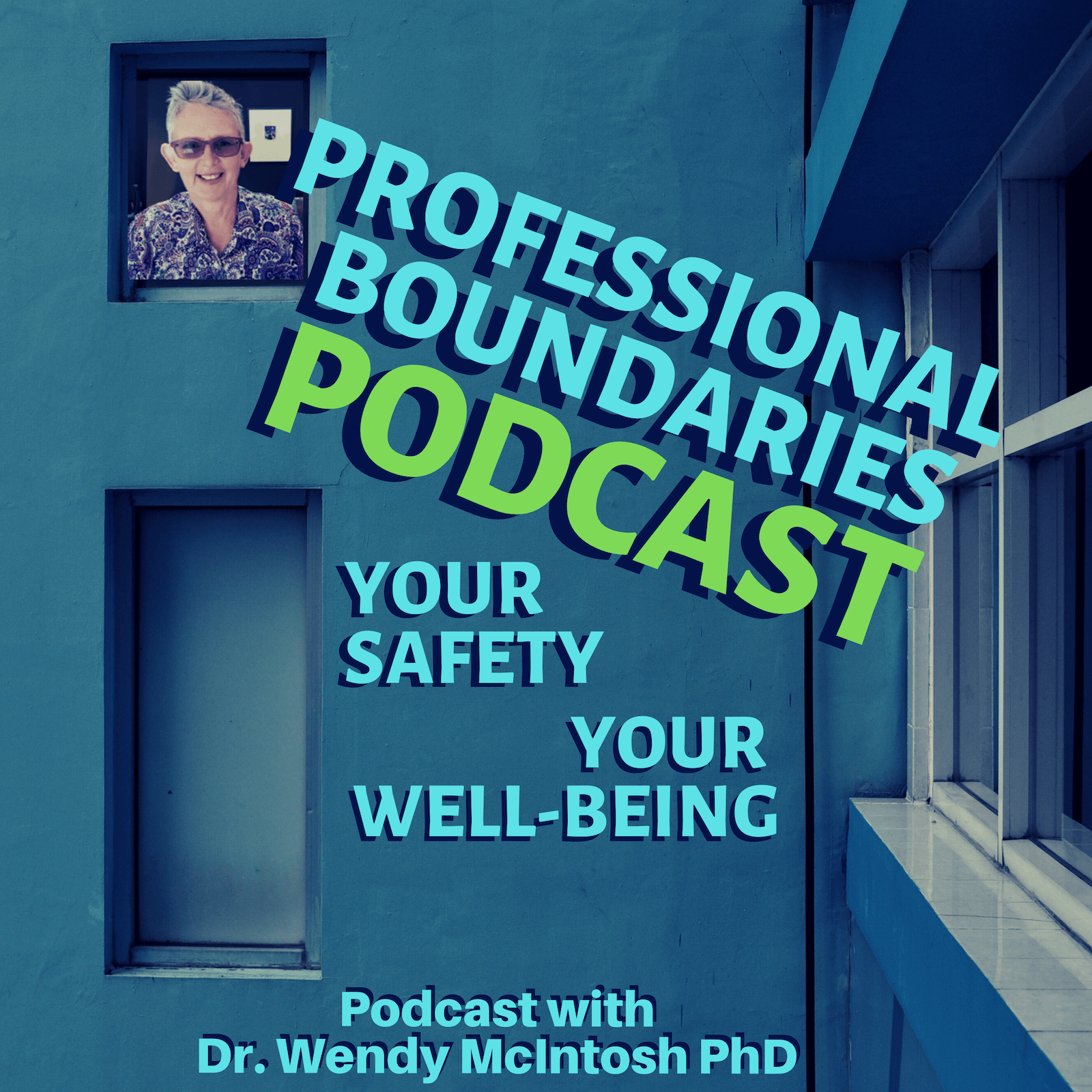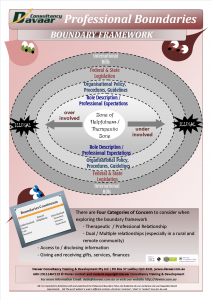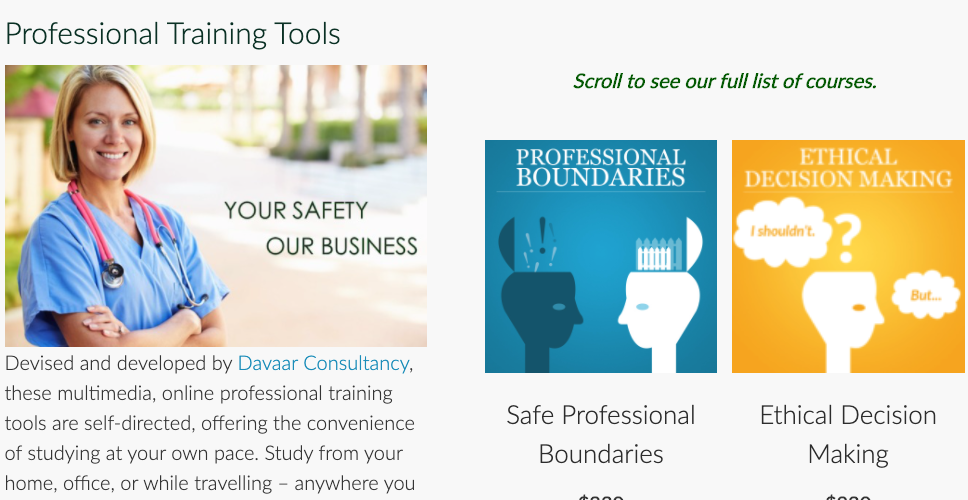Podcast: Play in new window | Download (Duration: 44:16 — 29.6MB)
Subscribe: Apple Podcasts | Spotify | TuneIn
Episode 3 – The professional Boundaries framework. Staying in the Zone of Helpfulness

In Episode 3, Dr Wendy McIntosh PhD from Davaar Consultancy shares another Professional Boundaries scenario and ways to identify when a professional’s behaviour risks boundary crossings or violations, or if a transgression might already have occurred.
Listen as Dr Wendy explains the Professional Boundary Framework model she uses in her workshops to help participants get a visceral feeling of the Professional Boundaries continuum. This episode introduces powerful and specific questions to ask while examining situations that are ripe for crossings or  transgressions and delves deeper into the reasons that they occur. The discussion of Red flags continues in this episode.
transgressions and delves deeper into the reasons that they occur. The discussion of Red flags continues in this episode.
This is the third part of a dialogue that be will be continued in the following episodes. Use the links above to subscribe, or click the play button to listen.
Listen to Episode 4 here.
There are 6 episodes planned in this first season of the Professional Boundaries Podcast and we hope you’ll be back to enjoy and learn from each of them. If you’ve ever wondered about your own boundaries in your Professional role, or been alerted about the risks of crossings or violations, this podcast will help you learn what to watch for, and ways to stay out the danger zones.
Dr Wendy McIntosh welcomes both your interest and curiosity. Send Wendy questions at wendy@davaar.com.au or via Twitter, Instagram or Linked In

Dr. Wendy McIntosh PhD
Since 2005 Wendy has been developing her knowledge and interest in the area of professional boundaries. Wendy delivers workshops on boundaries in Australia (where she now lives) and Internationally when invited to do so. She is continually integrating learning and insights she gains from the work she does in professional boundaries. Wendy comes from a nursing, and predominately psychiatric nursing, background.
Wendy consistently receives feedback on her passion, knowledge, and creativity as a presenter and facilitator. Enjoy exploring boundaries in this podcast series as Wendy takes you on your own reflective journey on your professional boundaries.
References:
Gutheil, T. G., & Brodsky, A. (2008). Preventing boundary violations in clinical practice. The Guildford Press: New York.
Quote from Plato – https://www.brainyquote.com/authors/plato-quotes
Music clips in this podcast:
“Perspectives” by Kevin MacLeod (https://incompetech.com) &
“Middle Earth ” by Jason Shaw (https://audionautix.com)
License: CC BY (http://creativecommons.org/licenses/by/4.0/)
Transcript: Podcast Three – The professional boundary framework – where possible keep in the Zone of Helpfulness
Scenario
She lived and worked in a small town.
She was only six months into her role as a support worker
She had lived in the community for 5 years.
She was aware of the organisation’s code of conduct which had a section on boundaries.
She had read the document, she had assessed that she had a good understanding of the content.
She was surprised then when her team leader asked to see her, a complaint had been made against her.
The complaint had been made by the daughter of a customer she was seeing. The complaint stated that the support worker had got too close to the complainant’s mother, the complainant stated “she (the support worker) is spending more time with my mother than is required. Now my mother makes comments to her like “you are just like a daughter to me, dear”.
Welcome to this Podcast series – Professional Boundaries, Your safety, your wellbeing. I am Wendy Mcintosh from Davaar Consultancy and I am delighted that you are joining me on another journey of exploration, revelation and for some, consolidation, on the theme of professional boundaries. This is our third episode in a series of six. Each episode focuses on a different aspect of professional boundaries and aims to extend your understanding of professional boundaries. Further, the podcast explores ways in which Professional Boundaries can assist you in your work and perhaps even in your everyday life. Feedback from participants who have completed training with me, share how insights and learning they gained about professional boundaries has assisted them with boundaries in their personal relationships.
I would love to have your input through questions, scenarios to explore, reflections from each podcast. One of my aims for these podcasts is to have you engaged in this process with me. I know from experience that having discussions about boundaries and what it means for us in the work and services we provide is an important step in assisting us to understand motivations for our actions. Contact details are provided at the end of this podcast.
The beginning is the most important part of the work – Plato
This episode focuses on the foundation stone of the Professional Boundary Framework. I really enjoy exploring the framework in the boundary workshops I conduct because I use an experiential process to assist participants. Using different colours of materials I present the framework as a sculpture on the floor. This means that I and participants can walk up and down the framework and have a visceral experience of where they might be on the framework in terms of work they are doing with patients, and or collegial relationships. In the invite to folks to experience the framework, I invite them to be curious about what might take them out of the Zone of Helpfulness into the continuum of an over or under involved relationship with the other person. In exploring the framework through action I also ask participants to be aware of red flags and also strategies to assist them to return to the Zone of Helpfulness.
Major benefits I see to understanding the boundary framework in the context of professional relationships is that we can use it as –
a risk assessment framework (we can pose the question – where on the continuum am I)
an awareness framework – (we can pose many curious questions – what / who led me here?)
a solutions framework – (ok this is where I am – what do I need to get back to the zone of
helpfulness)
I am thinking that it would be useful to describe the framework to assist you have a picture of it as I invite you to wander up and down exploring the two scenarios presented at the beginning of the podcast, revisiting my scenario from podcast two – Caring enough to put my life on the line and also reflecting on relationships you have with patients and or colleagues. For an image of the boundary framework similar to what I use in the workshops I deliver, you can visit our website and in the podcast section, you will be able to see the framework. For the purpose of this podcast, I will explain it as though we are in a car driving.
Imagine you are at an intersection on a road, in boundary land this intersection is the Zone of Helpfulness also referred to as the Safety Zone and Therapeutic Relationship Zone. If you turn left you are going into the over-involved area, if you turn right you are going into the under-involved area. In this road, the interaction is actually the safest place in which to practice. At either end of the left hand or right-hand turn, there is a big road sign that says illegal. We definitely do not want to end up there. As we look in either direction what we see is that the roads are an ever-darkening shade of grey until the endpoint here the word illegal is black.
If I turn left into the over-involved road – some commonly reported behaviours will be demonstrated – spending unpaid time with a client, lending a client money, interacting with the client on social media, giving gifts to the client that could include, food, clothing, tickets to the movies. On the over-involved road, the professional may spend a lot of time thinking about the client and how to make things better for them, perhaps there is some magical thinking about how to make their circumstances better for them. Better – as perceived by the professional.
If I turn right onto the under-involved road common experiences are a disinterest in the client, talking about them in negative tones, use of pet names – such as pet, darling, dear. An emotional distancing that is cold and rigid. There may also be neglect and abandonment of the client’s needs.
There are four large billboards which have important messages for us to consider in terms of professional relationships. Each is a guide to assist the professional reflect on the context of their role. These billboards are visible on both the over and under involved roads.
The largest billboard is World considerations – such as the Universal Declaration of Human Rights
The next billboard is Federal and state legislation on safety and professional regulatory expectations (laws relevant to the countries in which you live and work)
Another billboard represents organisational policies, procedures, and guidelines with professional boundary expectations in there.
The final billboard represents the job description and expectations of the professional role
These four billboards (represented as circles in the image we present on our website), and all they contain, form the CONTEXT of what is required in the professional relationship between a professional and a client. Be that as an employee such as a support worker, teacher, police officer, council worker, health professional or an independent practitioner such as a counsellor or health professional.
There is another element to the road – that is a pathway that also goes left and right that forms the intersection. The pathway is uneven. This pathway symbolises the actions and speech content of the professional and the interpretation/understanding that the client has, about what was said, what occurred. Remember from podcast two my assessment that what I did was a careless thoughtless act, the patient’s interpretation – someone cared enough about her to put their life on the line.
Let me explore that idea of the interpretation of actions with some further discussion on the scenario from this podcast. I shall begin with some context.
The customer was in her 70s. She was known to the support worker because they lived in the same community. Prior to the commencement of the professional role their interactions had been brief community interactions when they met at social events. The only family member the lady had was her daughter who lived in another town and could only visit her mother every month when she would stay overnight with her. The support worker’s paid role was to visit the client twice a week to take her shopping, ensure she had enough food and to help her prepare meals if required.
As the professional relationship developed – the support worker found that she looked forward to spending time with the client. The time they spent together extended into unpaid time – the support worker would visit the customer in her own time. She started to take meals that she had prepared, to the customer.
When the team leader inquired as to the extra time and meals provided the support worker responded “well she is so lonely, I just did what any caring person would do. The customer always tells me how much she enjoys my visits”.
It is so easy for two completely different interpretations, two different meanings, two different stories to be created in a single act, in a single sentence, in a pattern of behaviour.
When the team leader talked with the customer – she responded “she is very nice to me, other support workers have not done that, come to visit me or bring me meals. She is like my daughter – that’s what my daughter does for me”. The customer also made another comment to the team leader which amplified a red flag for the team leader. The comment was “I feel so sorry for her. You know she lost her own mother just over a year ago”.
So I now pose some questions to you –
did a transgression occur and if so was it a crossing or a violation?
was it over or under involved?
– or both?
When we briefly revisit the definitions discussed in podcast two, we are reminded that a crossing occurs once and is generally considered to be thoughtless or inadvertent. A violation is a pattern of behaviour where the needs of the professional supersede the needs of the client.
Based on those definitions we could assess that in the scenario – the boundary transgression was a violation. Was the transgression over or under involved, or indeed both? Well, that question may take some time to discuss. So we are going to pause here to consider this very important question – was the behaviours of the support worker over or under involved or both?
I have learnt through the hundreds of sessions I have conducted with professionals, through scenarios presented and explored in the workshops I conduct, that an over-involved professional boundary actually informs us that it is the person who is over-involved, not the professional. Hang in with me whilst I explain further.
If I am acting in the requirements and expectations of my professional role in the context that I am employed then I cannot actually be professionally over-involved, however, I absolutely can be personally over-involved. I have become personally over-invested in the person and in the relationship I have with the other person.
Now, this is where I really appreciate the complexities that are professional boundaries – if I am personally over-involved then there actually is a very good chance that at the same time I am professionally under involved. The personal aspect of the relationship has become so important to me that I stop noticing what I need to be noticing in my professional role, the role that I am being paid to do.
In all examples of where I have worked with individuals due to over-involved transgressions when we explore the under-involved aspect of service provision – whilst hard and confronting to hear – individuals appreciate that the professional objectively switched down or off and the emotional personal got going.
You could use the framework right now to further understand the complexity of being personally over-involved and professional under involved by reflecting on a situation from your professional role, historically or currently. It is always beneficial to consider an over-involved scenario and then identify – am I also under involved here.
Place yourself on the framework – how far away from the intersection – that safe Zone, that Zone of Helpfulness – have you travelled with your client. Look back and notice that the further away from the intersection you are, the further away you will also be from providing the care, the service that you are being paid to do – thus, you are also under involved.
Context is important.
If we consider those four important boundary questions from podcast two we can also get further data:
1. What was the intent or purpose of the support worker’s actions?
First base to provide care for the customer (remember she was also being paid to provide care within the remit of her paid role)
Burrow down – she felt better because of the extra services she provided. She also liked to hear comments from the customer that no other support worker had shown so much care, that made her feel wanted.
2. Whose needs were being met?
First base the customers – burrow down – the support worker felt needed by the customer and that made her feel good, more significantly however was that being with the customer reminded her of being with her mother. Being with the customer she experienced a comfortable and familiar relationship. The professional’s emotional and psychological needs
were being met.
3. Was there other options for the support worker?
Yes many, however in order to allow any other options to present – the support worker would have had to have the awareness that was she was doing did not meet her organisational code of conduct.
Had the support worker had an awareness of her actions she could have spoken with her TL before continuing on the journey she had started.
The support worker stated that she had understood the code of conduct content in terms of boundaries – yet her actions demonstrated this was not the case. She really was surprised to learn that not only had she transgressed the boundary – she had violated the boundary. Her prior understanding of boundary violation was that it must be close to or an actual illegal activity, such as fraud, assault, neglect. She thought that developing a sexual relationship would also be considered a violation. She had never contemplated that visiting the customer in her own time and providing meals would be considered a violation. For the organisation in which she worked, it was. Context is important.
4. What stopped her using another option?
In this scenario – a lack of awareness and not enough knowledge or experience to assist her to discern that her behaviour was a breach of her organisation’s expectations for her role. In a later podcast we will learn that personality features, relationship issues at home and or in the workplace, the influence of drugs and or alcohol, workplace cultures of bullying, vicarious trauma and burnout can be influencing factors in terms of stopping individuals using options in the professional relationships they have with their clients.
It was clear when data was collected that the support worker had not acted out of malicious intent, she had however used the power of her role to get her own needs meet. She had not fully appreciated the organisational requirements regarding boundaries. At no time was she curious about her pattern of behaviour or what it might mean for the customer or her daughter, or indeed for herself as a support worker, her employer or her colleagues.
I am just going to let that seep in for a little while and at the same time introduce another element that is integral to the boundary framework, and that is Categories of Concern.
Wearing our Sherlock Holmes inquiring hat – I see that the categories of concern element invites us to ask further curious questions to assist us to solidify was there a transgression and if so what kind.
The four categories of concern are:
Professional Role (or Therapeutic Role)
This refers to the job/role description and the context in which a person is employed. For some individuals, this will also require consideration of professional regulatory requirements.
Dual / Multiple relationships
Dual refers to having a professional relationship with a client and at the same time having a personal relationship. This can occur in two ways.
Firstly the initial relationship was service provider (professional) and service receiver (customer). The power dynamic exists – the professional has power the customer is vulnerable. Due to personal over-involvement, a secondary relationship develops (financial, sexual, friendship, service such as lawn mowing, car servicing, house painting). The professional is still been paid for providing a professional service and at the same time is conducting a dual relationship outside of working hours. Context is important here and it is important to clarify with the organisation which employs you and the professional group you belong to – what is the time frame for when a client is no longer considered a client.
The second dual relationship to consider is when there is a pre-existing relationship – family members, neighbours, sing in the same choir, play in the same football team and then one person becomes a client of the service to which the professional belongs. In such circumstances it is important that the professional discusses the pre-existing relationship with their team leader and look at options of service delivery – perhaps another person on the team can attend to the client. If that is not possible due to limited resources then the professional would have to talk with the client about “this new role relationship” they were about to commence and establish clear boundaries about that relationship. It would also be important that the professional is supported by the TL due to the increased complexity of the relationship.
Multiple relationships are also a reality in small communities where a professional providing services to the community such as as a teacher, health professional, police officer, etc also live in the community – and have other roles with a client such as a neighbour, attend their children’s school activities together, attend the same drama group, shop in the same shops.
It is ok to be in multiple relationships, it is the reality when working and living in a small community. The responsibility for the professional is to always ask the questions what role am I in just now and how do I respond to that question, that invite, that feedback from the other person. It is always the responsibility of the professional to be clear with the individual that they are engaging with. It will always be the responsibility of the professional to maintain the boundary and reset limits when and if transgressions occur.
The third category of concern to consider is that of – Access to / disclosure of information
It is always good to ask questions such as – what is the minimal amount of information I require about the patient in order to provide the service I am paid to do?
Similarly, in terms of self-disclosure, it is important to consider the context of the role the professional is being paid to do in order to understand how much information they are required to disclose about themselves.
How much is not enough, how much is too much – will be directed by the context. The important questions to ask as professionals self disclose to the patient is:
What is the intent/purpose of this disclosure?
Whose needs are being met? (remembering that it is always important to burrow down to those uncomfortable responses. They are uncomfortable because they are actually wise guides for you)
Do I share this information with all patients or just this one?
If I just share with this patient – what is occurring in our relationship?
If I share similar self-disclosure with all patients – what meaning does that have for me?
I have learnt that in asking such questions the answer about whether or not a transgression is about to or has occurred is revealed.
The final category of concern is that of Giving and receiving gifts, services, money.
Gifts can range from a bag of mangoes to a piece of jewellery worth thousands of dollars, to a house.
Services – includes activities that are not part of the job description nor service requirement from the organisation. Services may occur during the paid time that a professional is with a client or in time away from working hours. Services include and are not limited to; washing cars, doing laundry,
car servicing, walking dogs, hairdressing, massages.
Money – might be in the form of a professional lending a client money or vice versa. The client may pay for bills that the professional requires to be paid. Money may include being left a significant amount of money in a person’s will.
Context is important.
We can now use these categories to concern to further explore the scenario with the support worker and the customer.
In having contact with the customer in her own time – had the support worker stepped out of her professional role?
The answer is yes – there was nothing in her job description that said she had to have contact with the customer outside of work hours
Was the support worker operating in a dual relationship with the customer? – yes she was
Did the support worker disclose information that was not required within her job description? Yes. One red flag being the information provided by the customer that the support worker’s mother had died a year previously and she knew this because the support worker frequently talked about her mother when they were together.
Was there a giving and receiving of gifts services, finances – yes the meals would be considered both a gift and a service.
So in this seemingly innocuous transgression – the support worker had actually triggered all four categories of concern.
Again I repeat she was not a malicious person. She did not act with intent to use the power of her role with the customer’s vulnerability. However, that is actually what had happened.
A consistent comment made to me during workshops on boundaries is – “I don’t want to become robotic, I don’t want to lose my humanity, I don’t want to stop caring about the clients I see”.
I allow the comments to sit for a while because they are an expression of genuine concern for participants. Then I bring forward the notion that if we actually understand and appreciate the complexities that are boundaries, when we stand firm in the knowledge that each foundation stone provides to us when we engage in robust discussions about boundaries with colleagues and in the organisations where we work – then individuals experience a more authentic, generous and respectful relationship with the other person or persons.
The foundation stone that really assists participants appreciate the wonder of this – is that of the reasons for transgressions. When participants understand the dynamics that influence the patterns of behaviours they have with clients, those ah-ha moments free them up to be much more discerning in those professional relationships.
Before I move towards the end of this podcast – I would like to invite you to start considering strategies that could perhaps have been of assistance to this support worker, to decrease the risk of her transgressing the boundary with the customer. Just as importantly, if you were her team leader what would your next steps be with her.
I see that it is essential in that first meeting between the professional and the client to discuss the context of the professional roles and to invite an exploration of the other person’s understanding of what is being said and what the expectations are. In subsequent meetings it is important that the professional checks in with the client that the understanding is clear, looking for red flags that may indicate that a boundary transgression is about to occur or indeed has occurred. Commentary from a client such as “you are just like a friend to me”, “you are the son I never had”, or “I wish all nurses were as kind as you” may indicate that curious questions are required about the relationship. Ah yes, those red flags. I will be waving them loudly in the next podcast.
I have one further question to pose to you now that you have information about the boundary framework and categories of concern. When I stood between the patient and the wall, was my action a boundary-crossing or violation? Was the transgression over or under involved or both?
I will share more about my reflections on those questions with you in the next podcast.
You may recall in the previous podcast my reference to a list of needs that could be operating in the professional when they transgress a boundary. The list of needs include:
Physical including hugging, kiss on the cheek, hand on should, hand on the back
Psychological – where the professional self discloses personal information of themselves, where a professional may seek counsel from a customer and collegially where a team leader or supervisor over shares and seeks counsel from a junior member of staff
Emotional – where the client becomes the caretaker, counsellor for the professional
Financial – giving and receiving money, paying bills
Services – where the professional provides a service such as lawn mowing, car maintenance, hairdressing and does not charge the person rather they are conducting the service out of an act of kindness, it is also possible that the client may provide such service to the professional as a way of thanking them for their care
Spiritual – in such instances the professional directs the conversation towards a spiritual or religious nature even when the other person has clearly stated I do not want to discuss this, or where the professional prays with the client and that is not part of their job description
Sexual – where the professional engages in a sexual way with the client – through comments, touch, sexual engagement.
One book that I have found very useful, and to which I refer to many times is Preventing Boundary Violations in Clinical Practice by Gutheil and Brodsky. Whilst the focus of the book is on the therapeutic relationship, it contains many gems to help extend an exploration of boundaries and what it means in the professional encounter.
This podcast series has been written by myself, Wendy McIntosh. A big thank you to family and colleagues who hear each podcast before it is released and who provide valuable editing feedback. Thank you to Nikki Fryn, my internet guru who has done the production for these podcasts.
As I said earlier I would love to hear from you, our listeners, any questions, scenarios, reflections that you want to be discussed as part of a podcast session. There is still much to learn and each question and scenario posed provides opportunities to expand learning about professional boundaries. My email address is wendy@davaar.com.au, you can also contact me through our social media of twitter and instagram and LinkedIn. I would be delighted for podcasts to be as meaningful as possible to all who listen. So join with me.
The spelling for Davaar is D for Donald, A for awareness, V for victor, A for awareness, A for Alert, R for Red flags.
Thank you for listening. Let’s meet again in session four.




 our registration form
our registration form